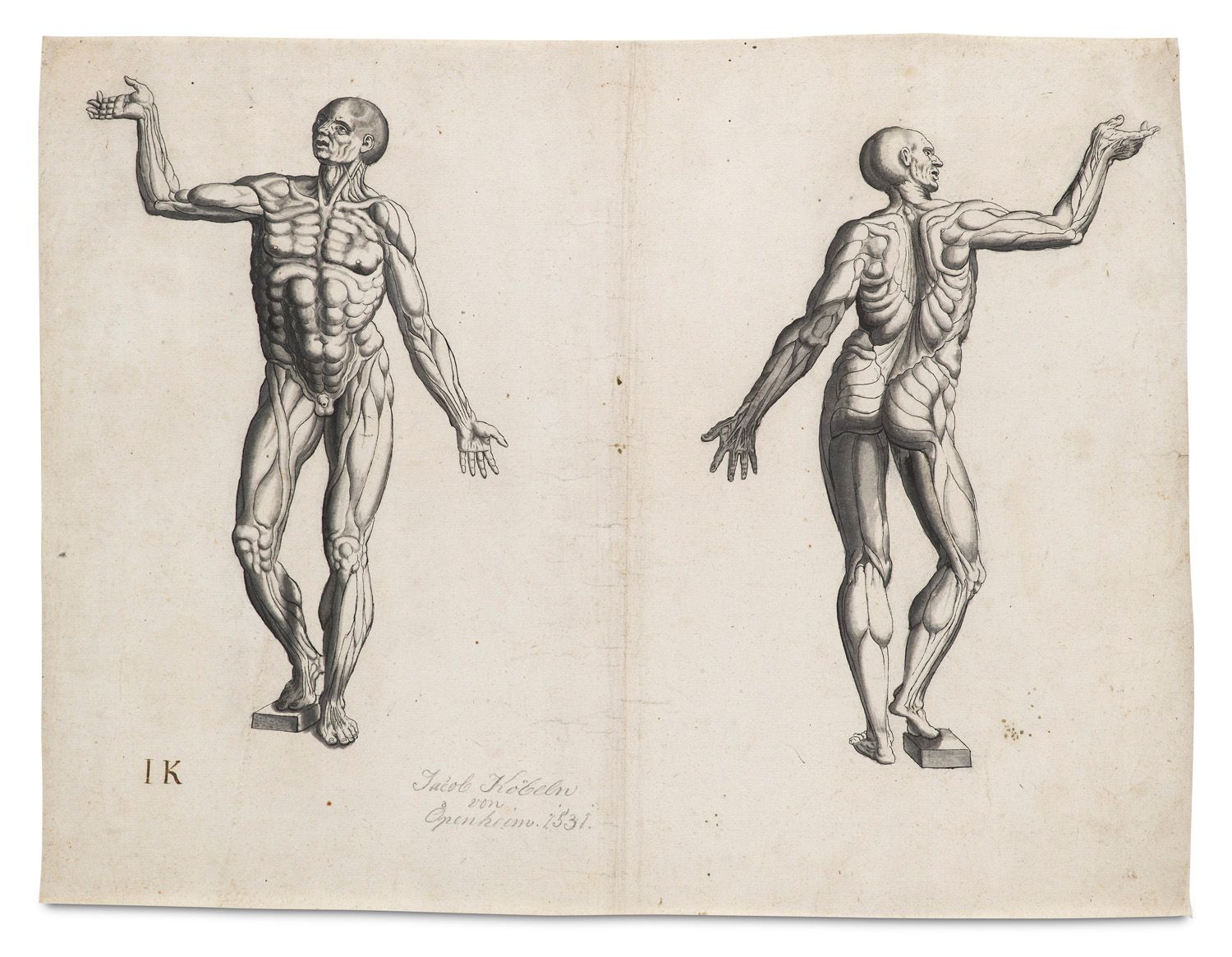Description
Kallenberg, Jakob Zwei Zeichnungen auf einem Blatt mit anatomischen Darstellungen eines Mannes in Vorder- und Rückenansicht. 1. Hälfte des. 16. Jhds. Je schwarze Feder- und grau-lavierte Tuschfederzei…
Old art - Drawings Kallenberg, Jakob Two drawings on one sheet with anatomical depictions of a man in front and back view. 1st half of the 16th century. Each black pen and ink drawing with gray wash on buff laid paper (with unidentifiable watermark with heraldic double-headed eagle). Monogrammed lower left and additionally inscribed by another hand in pencil "Jacob Köbeln von Openheim 1531". 29.8 x 30 cm. - Margins slightly irregularly trimmed. Very short marginal tear (ca. 3 mm) lower left and center right. Slightly unfresh in the margins. With a total of 4 very small and barely noticeable holes, each outside the image. With vertical and smoothed centerfold in the middle. Verso in three corners each with slight traces of former mounting. Overall in very good condition. Nagler, Monogr. III, 2682, Brun. SKL II, 1908, cf. Hollstein, Deutsch XV2, 205-212 - The oeuvre of the Swiss Jakob Kallenberg was always attributed to the work of Jakob Köbel (1462 -1533) according to the old state of research, which presumably goes back to the identical initials "IK" of the two artists. Nagler still considered Kallenberg to be an unknown master. According to the latest findings, his oeuvre comprises an extensive and significant body of work, which is primarily characterized by woodcuts and whose main work is "Wapen, Des heiligen Römischen Reichs Teutscher Nation", which is also known as the Fahnenbuch and was published in 1579. Other important woodcuts can be found in the well-known folk book "Schimpf und Ernst" (1546), published by Johannes Pauli. Our sheet shows the anatomical depiction of the muscle and tendon cords of a male nude from the front and back in an accomplished manner. The body of the man is positioned with one foot on a rectangular stone slab, which is reminiscent of the depiction of the contrapposto with supporting and free leg and, in addition to the advantage of ideal presentation for anatomical purposes, also has aesthetic benefits. This is supported by the chronological correspondence with the pictorial tradition of the contraposto, which has enjoyed great popularity as an antique design medium since its rediscovery by Renaissance artists. For his drawing, Kallenberg worked with a fine black pen, which captures the contours in clear lines, and a delicately graduated wash in shades of grey, which brings them out in an extremely refined way: in addition to the aesthetic level and the elaboration of plasticity, the anatomically adequate character of the depiction of the body is emphasized. As a result, the body not only appears lifelike, but also extremely finely modeled thanks to the effective contrast between light and dark. Anatomical study depictions were very popular from the 16th century onwards, offering artists the ideal opportunity to study the human body and train their ability to depict (parts of) the body correctly. Kallenberg's oeuvre contains many depictions of people, both in drawings and prints, although there are few anatomical or nude depictions. Stylistically, the influences of the Italian and Nordic Renaissance, such as the so-called Augsburg School and Holbein's circle, are evident. Two drawings on one sheet with anatomical depictions of a man in front and back view. Each black feather and grey-wash pen and ink drawing on buff laid paper (with unidentifiable watermark with heraldic double-headed eagle). Monogrammed lower left and additionally inscribed by another hand in pencil "Jacob Köbeln von Openheim 1531". - Margins slightly irregularly cut. Lower left and middle right with a very short marginal tear (approx. 3 mm). Slightly unfresh in margins. With a 4 very small and barely noticeable holes, each outside the depiction. With vertical and smoothed centerfold. On the verso in three corners slight traces of former mounting. Overall in a very good condition. - According to the old state of research, the oeuvre of the Swiss artist Jakob Kallenberg was always attributed to the work of Jakob Köbel (1462 -1533), which presumably goes back to the identical initials "IK" of the two artists. Nagler still categorized Kallenberg as an unknown master. According to the latest findings, his oeuvre comprises an extensive and significant body of work, which is primarily characterized by woodcuts and whose main work is "Wapen, Des heiligen Römischen Reichs Teutscher Nation", which is also known as the Fahnenbuch and was published in 1579. Other important woodcuts can be found in the well-known folk book "Schimpf und Ernst" (1546) published by Johannes Pauli. Our sheet shows the anatomical depiction of the muscle and tendon cords of a male nude from the front and back in a skilful manner. The body of the man is positioned with one foot on a rectangular stone slab which is reminisce
1359
Kallenberg, Jakob Zwei Zeichnungen auf einem Blatt mit anatomischen Darstellungen eines Mannes in Vorder- und Rückenansicht. 1. Hälfte des. 16. Jhds. Je schwarze Feder- und grau-lavierte Tuschfederzeichnung auf chamoisfarbenem Bütten (mit nicht identif
